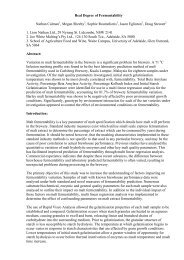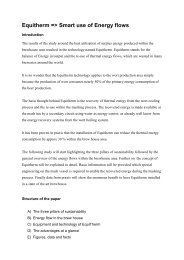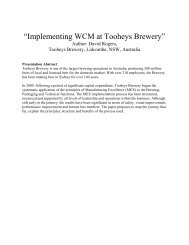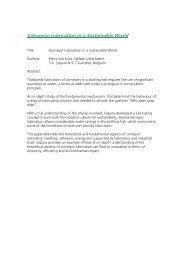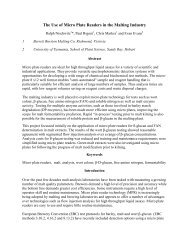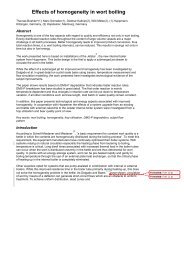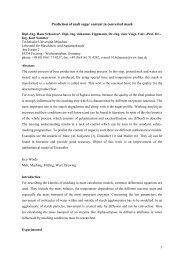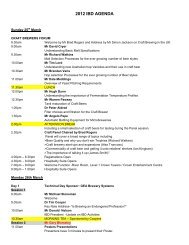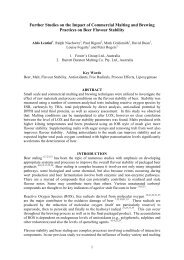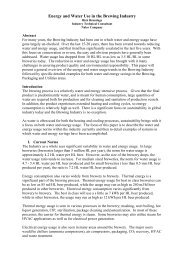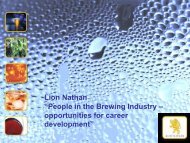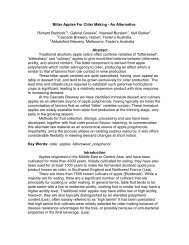Influence of Whisky Congeners on Health - The Institute of Brewing ...
Influence of Whisky Congeners on Health - The Institute of Brewing ...
Influence of Whisky Congeners on Health - The Institute of Brewing ...
Create successful ePaper yourself
Turn your PDF publications into a flip-book with our unique Google optimized e-Paper software.
<str<strong>on</strong>g>Influence</str<strong>on</strong>g> <str<strong>on</strong>g>of</str<strong>on</strong>g> <str<strong>on</strong>g>Whisky</str<strong>on</strong>g> <str<strong>on</strong>g>C<strong>on</strong>geners</str<strong>on</strong>g> <strong>on</strong> <strong>Health</strong><br />
Yoshihide Suwa*, Asuka Nemoto, Minako Koike, Eri Tsutsumi, Kayo Numaga, Seiichi<br />
Koshimizu, Kazuo Nakatani ( Suntory Ltd., Osaka,Japan ), Kenji Oguchi (Gifu<br />
Internati<strong>on</strong>al <strong>Institute</strong> <str<strong>on</strong>g>of</str<strong>on</strong>g> Biotechnology, Gifu, Japan ), Haruo Nukaya ( University <str<strong>on</strong>g>of</str<strong>on</strong>g><br />
Shizuoka, Shizuoka, Japan ), Hiroyuki Haraguchi (Fukuyama University, Hiroshima,<br />
Japan ), Noriaki Shirasaka, Hajime Yoshizumi (Kinki University, Osaka, Japan ),<br />
Chihiro Yabe (Kyoto Prefectural University <str<strong>on</strong>g>of</str<strong>on</strong>g> Medicine, Kyoto, Japan ), Kusuki<br />
Nishioka (St. Marianna University, School <str<strong>on</strong>g>of</str<strong>on</strong>g> Medicine, Tokyo, Japan )<br />
Abstract<br />
Experimental or clinical data <strong>on</strong> whisky c<strong>on</strong>gener showed different effects to purine and<br />
carbohydrate metabolism and melanin synthesis from other types <str<strong>on</strong>g>of</str<strong>on</strong>g> alcoholic beverages.<br />
Moderate drinking <str<strong>on</strong>g>of</str<strong>on</strong>g> whisky did not enhance serum uric acid level, blood glucose, and<br />
insulin level in healthy male subjects. <str<strong>on</strong>g>Whisky</str<strong>on</strong>g> c<strong>on</strong>gener showed the eliminative<br />
properties <str<strong>on</strong>g>of</str<strong>on</strong>g> serum uric aid by excreti<strong>on</strong> from blood to urine.<br />
Sec<strong>on</strong>dly, whisky c<strong>on</strong>gener suppresses the activity <str<strong>on</strong>g>of</str<strong>on</strong>g> aldose reductase (AR). AR<br />
inhibitors have been developed to prevent or to be effective for mild to moderate<br />
symptoms <str<strong>on</strong>g>of</str<strong>on</strong>g> diabetic complicati<strong>on</strong>. No AR inhibiti<strong>on</strong> was observed in beer, wine, and<br />
Shochu; a Japanese distilled liquor that does not involve any aging process in oak casks.<br />
In whisky c<strong>on</strong>geners, the l<strong>on</strong>ger it is aged in oak casks, the str<strong>on</strong>ger the AR inhibiti<strong>on</strong>.<br />
<strong>The</strong> active fracti<strong>on</strong> from the c<strong>on</strong>gener c<strong>on</strong>sists <str<strong>on</strong>g>of</str<strong>on</strong>g> the compounds that have<br />
1-formylpylogallol structure in their molecule. Especially, ellagic acid, which is <strong>on</strong>e <str<strong>on</strong>g>of</str<strong>on</strong>g><br />
the major comp<strong>on</strong>ents in whisky c<strong>on</strong>gener, has an inhibitory effect <strong>on</strong> the producti<strong>on</strong> <str<strong>on</strong>g>of</str<strong>on</strong>g><br />
sorbitol in rat erythrocyte. Urolithin, a metabolite <str<strong>on</strong>g>of</str<strong>on</strong>g> ellagic acid, was shown to be<br />
effective in the reducti<strong>on</strong> <str<strong>on</strong>g>of</str<strong>on</strong>g> sorbitol accumulati<strong>on</strong>. <str<strong>on</strong>g>Whisky</str<strong>on</strong>g> c<strong>on</strong>gener also eliminated the<br />
absorpti<strong>on</strong> <str<strong>on</strong>g>of</str<strong>on</strong>g> sucrose from intestine.<br />
Thirdly, whisky c<strong>on</strong>gener has antioxidant activity in proporti<strong>on</strong> to the period <str<strong>on</strong>g>of</str<strong>on</strong>g><br />
maturati<strong>on</strong> in white oak barrels. Ly<strong>on</strong>iresinol was isolated from whisky and identified<br />
as a str<strong>on</strong>g antioxidant. It suppresses the synthesis <str<strong>on</strong>g>of</str<strong>on</strong>g> melanin in vitro and in vivo by the<br />
tyrosinase inhibiti<strong>on</strong>.<br />
Key Words; <str<strong>on</strong>g>Whisky</str<strong>on</strong>g>, <str<strong>on</strong>g>C<strong>on</strong>geners</str<strong>on</strong>g>, Diabetes, Gout, Melanin, Antioxidant
Introducti<strong>on</strong><br />
Studies <strong>on</strong> the effects <str<strong>on</strong>g>of</str<strong>on</strong>g> polyphenols c<strong>on</strong>tained in daily beverages <strong>on</strong> human health<br />
have focused mainly <strong>on</strong> flav<strong>on</strong>oids, including catechin and epigallocatechin gallate in<br />
tea, proanthocyanidin in red wine, naringenin and quercetin in citrus, or <strong>on</strong> their<br />
c<strong>on</strong>densed tannins (polymers). Stilbene, such as resveratrol in red wine and chlorogenic<br />
acid and caffeic acid in c<str<strong>on</strong>g>of</str<strong>on</strong>g>fee, have also been vigorously investigated from the<br />
perspective <str<strong>on</strong>g>of</str<strong>on</strong>g> preventative medicine.<br />
Main polyphenols present in whisky are different from those described above. <str<strong>on</strong>g>Whisky</str<strong>on</strong>g><br />
polyphenols are composed <str<strong>on</strong>g>of</str<strong>on</strong>g> ellagic acid derived from ellagitannin (which is<br />
hydrolyzable tannin), phenylpropanoids such as c<strong>on</strong>iferyl aldehyde, vanillin, and lignan.<br />
<strong>The</strong> effects <str<strong>on</strong>g>of</str<strong>on</strong>g> those ingredients <strong>on</strong> health have not been studied as much as those <str<strong>on</strong>g>of</str<strong>on</strong>g><br />
polyphenols such as the above-named flav<strong>on</strong>oids (Fig 1).<br />
Number <str<strong>on</strong>g>of</str<strong>on</strong>g> literatures<br />
3500<br />
3000<br />
2500<br />
2000<br />
1500<br />
1000<br />
500<br />
0<br />
catechin epicatechin resveratrol ellagic acid<br />
Figure 1 Comparis<strong>on</strong> <str<strong>on</strong>g>of</str<strong>on</strong>g> the number <str<strong>on</strong>g>of</str<strong>on</strong>g> studies <strong>on</strong> catechin, epicatechin,<br />
resveratrol, and ellagic acid.<br />
<strong>The</strong> number <str<strong>on</strong>g>of</str<strong>on</strong>g> literatures obtained from PubMed<br />
(http://www.ncbi.nlm.nih.gov/entrez/query.fcgi?db=PubMed). “catechin, ”<br />
“epicatechin,” “resveratrol,” or “ellagic acid” is used as a search term.
Polyphenols exude from the oak cask into whisky during years <str<strong>on</strong>g>of</str<strong>on</strong>g> aging. Some <str<strong>on</strong>g>of</str<strong>on</strong>g><br />
them go through degradative and oxidizing reacti<strong>on</strong>s to turn into a variety <str<strong>on</strong>g>of</str<strong>on</strong>g> substances.<br />
C<strong>on</strong>cerning the relati<strong>on</strong>ship to health, whisky was reported to have the same level <str<strong>on</strong>g>of</str<strong>on</strong>g><br />
antioxidant activity in blood as wine (3) . However, the effects <str<strong>on</strong>g>of</str<strong>on</strong>g> polyphenols in whisky<br />
<strong>on</strong> health remain unclear.<br />
We first started determining the biochemical pr<str<strong>on</strong>g>of</str<strong>on</strong>g>iles <str<strong>on</strong>g>of</str<strong>on</strong>g> whisky c<strong>on</strong>geners and<br />
compared the pharmacological acti<strong>on</strong>s estimated from the pr<str<strong>on</strong>g>of</str<strong>on</strong>g>iles with those <str<strong>on</strong>g>of</str<strong>on</strong>g> other<br />
alcohol-derived c<strong>on</strong>geners. We then isolated and purified active ingredients resp<strong>on</strong>sible<br />
for respective pharmacological acti<strong>on</strong>s to determine their chemical structures and<br />
examine the correlati<strong>on</strong> between structure and activity by using chemically synthesized<br />
analogs. To be more specific, we assessed the effects <str<strong>on</strong>g>of</str<strong>on</strong>g> whisky c<strong>on</strong>stituents <strong>on</strong> purine<br />
metabolism (hyperuricemia, gout), glucose metabolism (obesity, diabetes), and melanin<br />
biosynthesis in the skin.<br />
First, in relati<strong>on</strong> to purine metabolism, the questi<strong>on</strong> <str<strong>on</strong>g>of</str<strong>on</strong>g> whether alcohol drinking<br />
triggers hyperuricemia or gout had l<strong>on</strong>g been debated in the medical community until<br />
multiple epidemiological studies c<strong>on</strong>ducted in Western countries and Japan recently<br />
dem<strong>on</strong>strated that excessive intake <str<strong>on</strong>g>of</str<strong>on</strong>g> alcohol increases the risk <str<strong>on</strong>g>of</str<strong>on</strong>g> gout. In order to<br />
prevent those lifestyle-related diseases and improve c<strong>on</strong>sumers’ quality <str<strong>on</strong>g>of</str<strong>on</strong>g> life, the<br />
following two questi<strong>on</strong>s about drinking-related risks need to be answered (9) .<br />
1) Does moderate drinking also raise the serum uric acid level?<br />
2) Is there any difference in the serum uric acid level by the type <str<strong>on</strong>g>of</str<strong>on</strong>g> alcohol?<br />
Regarding (2), the effects <str<strong>on</strong>g>of</str<strong>on</strong>g> moderate ingesti<strong>on</strong> <str<strong>on</strong>g>of</str<strong>on</strong>g> distilled liquor <strong>on</strong> living<br />
organisms were not fully examined. In additi<strong>on</strong>, it is unknown whether a difference<br />
exists in uric acid metabolism between when drinking distilled liquor such as whisky<br />
and brandy that undergoes the process <str<strong>on</strong>g>of</str<strong>on</strong>g> aging in the oak cask and when drinking white<br />
liquor.<br />
Sec<strong>on</strong>d, we studied the relati<strong>on</strong>ship <str<strong>on</strong>g>of</str<strong>on</strong>g> whisky c<strong>on</strong>stituents with diabetes and obesity.<br />
Drinking alcohol had l<strong>on</strong>g been c<strong>on</strong>sidered to exacerbate type II diabetes. <strong>The</strong>se days,<br />
however, a number <str<strong>on</strong>g>of</str<strong>on</strong>g> epidemiological studies (1) dem<strong>on</strong>strated that moderate drinking<br />
rather helps prevent the <strong>on</strong>set <str<strong>on</strong>g>of</str<strong>on</strong>g> type II diabetes. Some studies (5) indicated a J-curve<br />
relati<strong>on</strong>ship between beneficial effects and risks, showing that moderate-to-minimum<br />
drinking helps prevent type II diabetes while excessive intake can induce the <strong>on</strong>set <str<strong>on</strong>g>of</str<strong>on</strong>g><br />
the disease (a study each in the U.S.A., Europe, and Japan).<br />
<strong>The</strong> c<strong>on</strong>diti<strong>on</strong> <str<strong>on</strong>g>of</str<strong>on</strong>g> diabetes worsens when complicati<strong>on</strong>s (diabetic retinopathy,<br />
nephropathy, and/or neuropathy) are present. Aldose reductase (AR) is an enzyme
esp<strong>on</strong>sible for the exacerbati<strong>on</strong> <str<strong>on</strong>g>of</str<strong>on</strong>g> these complicati<strong>on</strong>s. This enzyme is activated when<br />
the polyol metabolic pathway is highly activated in the cell. Accumulati<strong>on</strong> <str<strong>on</strong>g>of</str<strong>on</strong>g> sorbitol<br />
increased by activated AR is associated with the process <str<strong>on</strong>g>of</str<strong>on</strong>g> inducing diabetic<br />
neuropathy and other complicati<strong>on</strong>s (Fig 2). This is why AR inhibitors are used to treat<br />
diabetic neuropathy (4, 8).<br />
normal blood glucose level<br />
glucose glucose-6-P CO2<br />
high blood glucose level<br />
aldose reductase<br />
suppressi<strong>on</strong><br />
whisky comp<strong>on</strong>ents<br />
<br />
sorbitol fructose<br />
Figure 2 Pathogenesis <str<strong>on</strong>g>of</str<strong>on</strong>g> diabetic complicati<strong>on</strong>s<br />
diabetic complicati<strong>on</strong>s<br />
glycati<strong>on</strong> reacti<strong>on</strong><br />
oxidative stress<br />
[neuropathy, retinopathy, nephropathy]<br />
We investigated whether n<strong>on</strong>-volatile ingredients in whisky represses AR inhibiting<br />
activity and sorbitol accumulati<strong>on</strong> under a hyperglycemic c<strong>on</strong>diti<strong>on</strong>, as well as whether<br />
whisky c<strong>on</strong>geners inhibit absorpti<strong>on</strong> <str<strong>on</strong>g>of</str<strong>on</strong>g> glucose.<br />
Third, we evaluated the effects <str<strong>on</strong>g>of</str<strong>on</strong>g> whisky c<strong>on</strong>stituents <strong>on</strong> melanin synthesis in the<br />
skin. Being a dominant polyphenol member in whisky, ellagic acid is already available<br />
as a whitening agent approved by the Ministry <str<strong>on</strong>g>of</str<strong>on</strong>g> <strong>Health</strong>, Labour and Welfare in Japan.<br />
This substance inhibits the activity <str<strong>on</strong>g>of</str<strong>on</strong>g> tyrosinase resp<strong>on</strong>sible for melanin synthesis.<br />
Studies c<strong>on</strong>ducted so far <strong>on</strong> ellagic acids have focused <strong>on</strong> those derived from berries,<br />
not from whisky. In the present study, we compared the ability <str<strong>on</strong>g>of</str<strong>on</strong>g> whiskey c<strong>on</strong>geners<br />
and other alcohol c<strong>on</strong>geners to hamper the activity <str<strong>on</strong>g>of</str<strong>on</strong>g> tyrosinase and then tried to isolate<br />
and purify those active ingredients and determine their structures.
Experimental<br />
Purine and carbohydrate metabolism<br />
We (9) have shown the influences <str<strong>on</strong>g>of</str<strong>on</strong>g> moderate intake level <str<strong>on</strong>g>of</str<strong>on</strong>g> three types <str<strong>on</strong>g>of</str<strong>on</strong>g> alcoholic<br />
beverages which were beer, whisky, and Shochu, Japanese distilled liquor, <strong>on</strong> purine<br />
and carbohydrate metabolism <str<strong>on</strong>g>of</str<strong>on</strong>g> healthy male volunteers (7) . In additi<strong>on</strong> to it, the<br />
difference between two types <str<strong>on</strong>g>of</str<strong>on</strong>g> distilled spirits with (whisky) and without (Shochu) a<br />
process with oak wood-barreling storage, <strong>on</strong> uric acid metabolism and excreti<strong>on</strong> in<br />
volunteers, have been found.<br />
Uric acid in blood<br />
Purine base c<strong>on</strong>centrati<strong>on</strong> in beer was 64.4 mg/l, whereas the c<strong>on</strong>centrati<strong>on</strong> was much<br />
less in whisky and Shochu, being 0.20 mg/l and 0.07 mg/l, respectively.<br />
Serum uric acid level did not increase after drinking Shochu (Japanese distilled liquor),<br />
and it slightly decreased after drinking water or whisky. Thus, the serum uric acid<br />
level before and <strong>on</strong>e hour after drinking was 5.0±0.3 mg/dl and 4.8±0.3 mg/dl,<br />
respectively, for water, 5.4±0.2 mg/dl and 5.2±0.2 mg/dl for whisky, dem<strong>on</strong>strating<br />
decrease in c<strong>on</strong>centrati<strong>on</strong> (p < 0.001) in both cases. <strong>The</strong> serum uric acid level before<br />
and after drinking Shochu was 5.4±0.2 mg/dl and 5.2±0.2 mg/dl, respectively, with no<br />
significant difference being observed. In c<strong>on</strong>trast, drinking beer increased the serum<br />
uric acid level from the basal level <str<strong>on</strong>g>of</str<strong>on</strong>g> 5.1±0.3 mg/dl to 5.8±0.3 mg/dl, an increase <str<strong>on</strong>g>of</str<strong>on</strong>g><br />
0.7±0.1 mg/dl (p < 0.001) which corresp<strong>on</strong>ded to 13.6% increase from the basal level<br />
( Fig. 3). <strong>The</strong> pattern <str<strong>on</strong>g>of</str<strong>on</strong>g> urine producti<strong>on</strong> showed difference am<strong>on</strong>g three types <str<strong>on</strong>g>of</str<strong>on</strong>g><br />
alcoholic beverages. Thus, urine producti<strong>on</strong> started earlier in the beer group than in<br />
the distilled liquor groups, reaching the peak urine excreti<strong>on</strong> 1 to 2 hours after drinking<br />
beer, compared to 2 to 5 hours after drinking whisky ( p < 0.05). <strong>The</strong> urine volume<br />
tended to be smaller in the Shochu group than in the beer and whisky groups.
serum uric acid level (%)<br />
115<br />
110<br />
105<br />
100<br />
95<br />
90<br />
0 1 2 3 4 5<br />
hour<br />
Figure 3 Time course <str<strong>on</strong>g>of</str<strong>on</strong>g> serum uric acid level.<br />
beer<br />
Shochu<br />
whisky<br />
water<br />
Significant interacti<strong>on</strong>s were observed between each type <str<strong>on</strong>g>of</str<strong>on</strong>g> alcoholic beverage<br />
and time course. [ p
time, and the samples were subjected to the measurement <str<strong>on</strong>g>of</str<strong>on</strong>g> 58 biochemical<br />
markers related to uric acid metabolism, glucose metabolism, alcohol<br />
metabolism and hepatic, pancreatic and renal functi<strong>on</strong>s. Alcohol and<br />
acetaldehyde c<strong>on</strong>centrati<strong>on</strong>s in blood were determined using a headspace gas<br />
chromatography (type HS-101 8700), and oxypurine c<strong>on</strong>centrati<strong>on</strong> in urine was<br />
determined by colorimetry using a Hitachi type 736-15 automated analyzer.<br />
Am<strong>on</strong>g the 13 subjects, seven healthy males[mean age: 31.9±1.9 (S.E), serum<br />
uric acid: 5.0±0.3 mg/dL] who fulfilled the criteria specified in the study protocol<br />
throughout the study period were used as the final evaluable subjects.<br />
Alcohol intake at each drinking test (0.8 mL/kg body weight) was set at a level<br />
slightly higher than the moderate amount <str<strong>on</strong>g>of</str<strong>on</strong>g> alcohol described in the NIAAA<br />
review (2) (ca. 30.4 mL or less /male), taking into c<strong>on</strong>siderati<strong>on</strong> the possible<br />
individual difference in extrapolating the results <str<strong>on</strong>g>of</str<strong>on</strong>g> the study to healthy people<br />
and patients in general. Except for low purine beer, each beverage used in the<br />
study was commercially available and was purchased from a market.<br />
Excreti<strong>on</strong> <str<strong>on</strong>g>of</str<strong>on</strong>g> uric acid<br />
Serum uric acid c<strong>on</strong>centrati<strong>on</strong> tended to be c<strong>on</strong>sistently lower after drinking whisky<br />
than after drinking Shochu, another distilled liquor, although the difference was not<br />
significant (Fig 3). With the aim <str<strong>on</strong>g>of</str<strong>on</strong>g> clarifying whether comp<strong>on</strong>ents in whisky have<br />
activity to decrease serum uric acid c<strong>on</strong>centrati<strong>on</strong>, subjects were asked to drink whisky<br />
and Shochu in turn with intervals <str<strong>on</strong>g>of</str<strong>on</strong>g> <strong>on</strong>e week while eating high purine food<br />
( oil-packed sardines, total purine intake: approx 50 mg/subject ).<br />
As shown in Fig.4-a, serum uric acid c<strong>on</strong>centrati<strong>on</strong> was c<strong>on</strong>sistently lower by<br />
approximately 2 to 3% after drinking whisky relative to the c<strong>on</strong>centrati<strong>on</strong> after drinking<br />
Shochu or water. And the urinary excreti<strong>on</strong> <str<strong>on</strong>g>of</str<strong>on</strong>g> uric acid, which was measured<br />
simultaneously, increased by 27% after drinking whisky (Fig.4-b) ( p < 0.05 ).
serum uric acid level (%)<br />
115<br />
110<br />
105<br />
100<br />
urinary excreti<strong>on</strong> <str<strong>on</strong>g>of</str<strong>on</strong>g> uric acid (%)<br />
high purine food<br />
0 alcohol intake 1 2<br />
120<br />
100<br />
80<br />
hour<br />
140 (n= 7)<br />
Shochu whisky<br />
Shochu<br />
whisky<br />
n = 7
Figure 4 <str<strong>on</strong>g>Influence</str<strong>on</strong>g> <str<strong>on</strong>g>of</str<strong>on</strong>g> whisky drinking <strong>on</strong> excreti<strong>on</strong> <str<strong>on</strong>g>of</str<strong>on</strong>g> serum (a) and<br />
urinary excreti<strong>on</strong> (b) <str<strong>on</strong>g>of</str<strong>on</strong>g> uric acid<br />
Eight subject [30-54 years old (35.2 ± 4.1 (standard deviati<strong>on</strong>) years old; 7 <str<strong>on</strong>g>of</str<strong>on</strong>g><br />
whom remained eligible until the end <str<strong>on</strong>g>of</str<strong>on</strong>g> the study) ingested whisky or Shochu<br />
under the same c<strong>on</strong>diti<strong>on</strong>s as used in figure 3, and kinetics <str<strong>on</strong>g>of</str<strong>on</strong>g> uric acid<br />
metabolism were compared between the two distilled liquors. During the 30 min<br />
<str<strong>on</strong>g>of</str<strong>on</strong>g> drinking each beverage, the subjects were instructed to eat oil-packed<br />
sardines as a high-purine food (total purin intake: approx 50 mg/subject).<br />
Xanthine oxidase inhibiti<strong>on</strong><br />
In additi<strong>on</strong> to the increase <str<strong>on</strong>g>of</str<strong>on</strong>g> urinary excreti<strong>on</strong> <str<strong>on</strong>g>of</str<strong>on</strong>g> uric acid after drinking whisky, we<br />
examined the inhibitory activity <str<strong>on</strong>g>of</str<strong>on</strong>g> whisky to xanthine oxidase, the enzyme resp<strong>on</strong>sible<br />
for the biosynthesis <str<strong>on</strong>g>of</str<strong>on</strong>g> uric acid (Fig.5).<br />
purine body<br />
uric acid<br />
oxidati<strong>on</strong> crystallizati<strong>on</strong><br />
HN<br />
O<br />
O<br />
N<br />
H<br />
Figure 5 Uric acid biosynthesis pathway<br />
H<br />
N<br />
N<br />
H<br />
O<br />
needle crystal
Whiskies showed the tendency to inhibit the xanthine oxidase activity, and the<br />
inhibitory activity increased with the time whisky is stored in an oak cask (Fig. 6).<br />
Sake A<br />
Sake B<br />
Shochu A<br />
Shochu B<br />
Brandy A<br />
Brandy B<br />
<str<strong>on</strong>g>Whisky</str<strong>on</strong>g> A (aged 10 years)<br />
<str<strong>on</strong>g>Whisky</str<strong>on</strong>g> B (aged 10 years)<br />
<str<strong>on</strong>g>Whisky</str<strong>on</strong>g> C (aged 12 years)<br />
<str<strong>on</strong>g>Whisky</str<strong>on</strong>g> D (aged 18 years)<br />
<str<strong>on</strong>g>Whisky</str<strong>on</strong>g> E (aged 25 years)<br />
Activity at 250 μg / ml<br />
0 20 40 60 80 1 00<br />
XO inhibiting activity (%)<br />
Figure 6 Xanthine oxidase (XO)-inhibiting activity <str<strong>on</strong>g>of</str<strong>on</strong>g> whisky<br />
0.3 ml <str<strong>on</strong>g>of</str<strong>on</strong>g> the test substance was added to 2.6 ml <str<strong>on</strong>g>of</str<strong>on</strong>g> 15 μg/ml xanthine soluti<strong>on</strong><br />
and the mixture was preincubated, after which 0.1 ml <str<strong>on</strong>g>of</str<strong>on</strong>g> 0.044 unit/ml XO<br />
soluti<strong>on</strong> was added and the mixture was incubated for 5 min. Absorbance at<br />
290 nm was determined 5 min after the additi<strong>on</strong> <str<strong>on</strong>g>of</str<strong>on</strong>g> XO, and XO-inhibiting activity<br />
was calculated from the absorbance by using the following equati<strong>on</strong>:<br />
XO-inhibiting activity (%) = (absorbance in the presence <str<strong>on</strong>g>of</str<strong>on</strong>g> the test substance) /<br />
(absorbance in the presence <str<strong>on</strong>g>of</str<strong>on</strong>g> equal c<strong>on</strong>centrati<strong>on</strong> <str<strong>on</strong>g>of</str<strong>on</strong>g> alcohol) x 100<br />
We isolated and purified this XOI active ingredient under the procedures described in<br />
(figure 7) to identify the structure <str<strong>on</strong>g>of</str<strong>on</strong>g> ellagic acid. Regarding in vitro oxidase inhibiting<br />
activity, the 50% inhibiti<strong>on</strong> was achieved with 260 mg/L <str<strong>on</strong>g>of</str<strong>on</strong>g> whisky c<strong>on</strong>geners (single<br />
malt, 12 years <str<strong>on</strong>g>of</str<strong>on</strong>g> storage) or with 4.9 mg/L <str<strong>on</strong>g>of</str<strong>on</strong>g> ellagic acid, in comparis<strong>on</strong> with<br />
allopurinol, a treatment for hyperuricemia and grout.
whisky<br />
whisky c<strong>on</strong>gener<br />
liquid-liquid distributi<strong>on</strong><br />
(AcOEt、n-BuOH、H 2 2O) O)<br />
active fracti<strong>on</strong> (Kd=3.0-3.4)<br />
Figure 7 Isolati<strong>on</strong> and structural determinati<strong>on</strong> <str<strong>on</strong>g>of</str<strong>on</strong>g> the XOI active<br />
comp<strong>on</strong>ent from whisky<br />
Effect <strong>on</strong> diabetic complicati<strong>on</strong>s<br />
Glucose and insulin in blood<br />
Being a distilled liquor, whisky does not c<strong>on</strong>tain carbohydrates, and its calories are<br />
virtually 60% <str<strong>on</strong>g>of</str<strong>on</strong>g> those <str<strong>on</strong>g>of</str<strong>on</strong>g> beer, a fermented liquor, when the same amount <str<strong>on</strong>g>of</str<strong>on</strong>g> alcohol is<br />
c<strong>on</strong>sumed.<br />
Evaporati<strong>on</strong> and lyophilizati<strong>on</strong><br />
AcOEt and n-BuOH fracti<strong>on</strong><br />
Sephadex LH-20<br />
column chromatography<br />
Eluti<strong>on</strong> : MeOH<br />
active comp<strong>on</strong>ent<br />
HO<br />
HO<br />
Regarding the blood glucose level and blood insulin level after drinking alcoholic<br />
beverages, distinct differences were observed in these levels between beer and the two<br />
types <str<strong>on</strong>g>of</str<strong>on</strong>g> distilled liquor. Thus, blood glucose level and insulin level increased <strong>on</strong><br />
average by 26.7% and 5.1-fold, respectively, after drinking beer, whereas there were no<br />
changes in these parameters observed after drinking whisky or Shochu(Fig 8-a&b).<br />
O<br />
O<br />
O<br />
O<br />
Ellagic acid<br />
OH<br />
OH
whisky<br />
Evaporati<strong>on</strong> and lyophilizati<strong>on</strong><br />
whisky c<strong>on</strong>gener<br />
liquid-liquid distributi<strong>on</strong><br />
(AcOEt、n-BuOH、H 2 2O) O)<br />
AcOEt and n-BuOH fracti<strong>on</strong><br />
Sephadex LH-20<br />
column chromatography<br />
Eluti<strong>on</strong> : MeOH<br />
active fracti<strong>on</strong> (Kd=3.0-3.4)<br />
active comp<strong>on</strong>ent<br />
serum insulin insulin (μ (μ U/mL)<br />
30<br />
20<br />
10<br />
HO<br />
HO<br />
Figure 8 Plasma glucose and serum insulin levels after alcohol intake<br />
<strong>The</strong> experiment was c<strong>on</strong>ducted as described in Fig 3.<br />
<strong>The</strong> level <str<strong>on</strong>g>of</str<strong>on</strong>g> ellagic acid c<strong>on</strong>tained in the whisky used in this study was approximately 7<br />
O<br />
O<br />
O<br />
O<br />
Ellagic acid<br />
beer<br />
OH<br />
whisky<br />
OH<br />
0<br />
0 1 2 3 4 5<br />
alcohol intake<br />
hour
ppm. This level and its specific activity explained that ellagic acid was resp<strong>on</strong>sible for<br />
about 33.6% <str<strong>on</strong>g>of</str<strong>on</strong>g> whisky’s in vitro XOI activity.<br />
Aldose reductase inhibiti<strong>on</strong><br />
We assessed the effect <str<strong>on</strong>g>of</str<strong>on</strong>g> respective alcoholic beverages <strong>on</strong> AR activity. When 5 μL <str<strong>on</strong>g>of</str<strong>on</strong>g><br />
whisky, Sake, beer, or Shochu was added to the 1 mL <str<strong>on</strong>g>of</str<strong>on</strong>g> AR enzyme reacti<strong>on</strong> reagent,<br />
AR’s activity was inhibited by 94%, 8.4%, 0%, or 0%, respectively, showing that<br />
whisky was more potent in inhibiting the activity <str<strong>on</strong>g>of</str<strong>on</strong>g> the enzyme than any other<br />
beveragel (Fig 9). Adding 40% ethanol soluti<strong>on</strong> instead <str<strong>on</strong>g>of</str<strong>on</strong>g> an alcoholic beverage<br />
produced no inhibitory activity.<br />
low low inhibiting inhibiting activity activity High High<br />
whisky<br />
red wine<br />
Shochu<br />
beer<br />
Sake<br />
0 0.1 0.2 0.3 0.4<br />
<str<strong>on</strong>g>Whisky</str<strong>on</strong>g> products<br />
aged 21 years<br />
aged 17 years<br />
aged 12 years<br />
aged 10 years<br />
aged short period<br />
0 0.2 0.4 0.6<br />
1/ IC 50 ( L / mg )<br />
Figure 9 Aldose reductose (AR) inhibiting activitiy <str<strong>on</strong>g>of</str<strong>on</strong>g> whisky<br />
<strong>The</strong> reacti<strong>on</strong> mixture c<strong>on</strong>tained 0.1 M sodium phosphate buffer (pH 6.2), 150 μM<br />
NADPH, 10 mM DL-glyceraldehyde, enzyme (6) and test sample in a total<br />
volume <str<strong>on</strong>g>of</str<strong>on</strong>g> 0.1 ml. Test samples were dissolved in DMSO and added to the<br />
reacti<strong>on</strong> mixture resulting the final c<strong>on</strong>centrati<strong>on</strong> <str<strong>on</strong>g>of</str<strong>on</strong>g> DMSO <str<strong>on</strong>g>of</str<strong>on</strong>g> 1 %. <strong>The</strong> reacti<strong>on</strong><br />
was initiated by the additi<strong>on</strong> <str<strong>on</strong>g>of</str<strong>on</strong>g> glyceraldehyde and incubated for 30 min. <strong>The</strong><br />
decrease <str<strong>on</strong>g>of</str<strong>on</strong>g> absorbance was measured at 340 nm.
When ool<strong>on</strong>g tea or green tea was added as a n<strong>on</strong>-alcoholic,<br />
plant-compound-c<strong>on</strong>taining beverage, the enzyme activity was reduced by 55% or 54%,<br />
respectively. Those findings indicated that whisky was more potent in inhibitory<br />
activity than n<strong>on</strong>-alcoholic beverages as well (data not shown).<br />
When 10 μL <str<strong>on</strong>g>of</str<strong>on</strong>g> malt whisky <str<strong>on</strong>g>of</str<strong>on</strong>g> 5, 10, 15, 20, or 30 years <str<strong>on</strong>g>of</str<strong>on</strong>g> age was added to 1 mL <str<strong>on</strong>g>of</str<strong>on</strong>g><br />
the AR enzyme reacti<strong>on</strong> reagent, AR’s activity was suppressed by 20%, 32%, 33%,<br />
42%, or 56%, respectively, dem<strong>on</strong>strating that the inhibitory activity increased in<br />
proporti<strong>on</strong> to the age <str<strong>on</strong>g>of</str<strong>on</strong>g> the whisky (Fig 9). <strong>The</strong>se findings suggested that the AR<br />
inhibiting substances in whisky were oak compounds derived from the cask.<br />
To evaluate the AR inhibitory compounds from whisky c<strong>on</strong>gener, a systematic<br />
fracti<strong>on</strong>ati<strong>on</strong> was carried out and their effects <strong>on</strong> hrAR were tested. <strong>The</strong> n-BuOH<br />
fracti<strong>on</strong> was found to exhibit the str<strong>on</strong>gest AR inhibitory activity, its IC50 being 1.5<br />
mg/L. An active principle as a potent AR inhibitor was isolated from this active<br />
n-BuOH fracti<strong>on</strong> and its chemical structure was identified as ellagic acid by spectral<br />
analysis and comparing it with published data in the literature. Ellagic acid exhibited a<br />
significant inhibiti<strong>on</strong> <str<strong>on</strong>g>of</str<strong>on</strong>g> AR in c<strong>on</strong>centrati<strong>on</strong>-dependent manner, its IC50 value being<br />
0.067 mg/L. <strong>The</strong> potency <str<strong>on</strong>g>of</str<strong>on</strong>g> this compound appeared equal to that <str<strong>on</strong>g>of</str<strong>on</strong>g> the known ARI,<br />
ONO-2235 (Epalrestat) (data not shown).<br />
Sorbitol was accumulated in erythrocytes when they were incubated in the medium<br />
c<strong>on</strong>taining 30mM glucose. In the presence <str<strong>on</strong>g>of</str<strong>on</strong>g> ellagic acid, sorbitol accumulati<strong>on</strong> was<br />
inhibited in a dose-dependent manner (Fig. 10). At 100 mg/L, sorbitol accumulati<strong>on</strong><br />
was inhibited by 70 %. In comparis<strong>on</strong> with ONO-2235, which exhibits an IC50 <str<strong>on</strong>g>of</str<strong>on</strong>g><br />
1.5×10 -6 M, ellagic acid was less potent.<br />
Although less potent than drugs, the specific activity <str<strong>on</strong>g>of</str<strong>on</strong>g> whisky c<strong>on</strong>geners against AR<br />
bel<strong>on</strong>gs to the most potent class for foods and beverages including alcoholic drinks. We<br />
are evaluating the AR inhibiting activity <str<strong>on</strong>g>of</str<strong>on</strong>g> ellagic acid metabolites now.
sorbitol in erythrocytes<br />
(nmol/mLRBC)<br />
glucose<br />
5.5mM<br />
glucose<br />
30mM<br />
glucose<br />
ellagic<br />
acid<br />
1 mg/L<br />
glucose<br />
glucose<br />
glucose<br />
30mM 30mM 30mM 30mM<br />
+ + + +<br />
ellagic<br />
acid<br />
3 mg/L<br />
ellagic<br />
acid<br />
10 mg/L<br />
Epalrestat<br />
3 mg/L<br />
Figure 10 Ellagic acid inhibits the accumulati<strong>on</strong> <str<strong>on</strong>g>of</str<strong>on</strong>g> sorbitol in<br />
rerythrocytes<br />
Blood was collected into a heparinized tube from the abdominal aorta <str<strong>on</strong>g>of</str<strong>on</strong>g> the rats.<br />
Erythrocytes were obtained by centrifugati<strong>on</strong> at 2000 xg and washed with cold<br />
saline twice. 1 ml <str<strong>on</strong>g>of</str<strong>on</strong>g> erythrocytes was added into 3 ml <str<strong>on</strong>g>of</str<strong>on</strong>g> Kreb’s-Ringer<br />
bicarb<strong>on</strong>ate buffer, c<strong>on</strong>taining 30 mM glucose and each compound dissolved in<br />
30 μL <str<strong>on</strong>g>of</str<strong>on</strong>g> dimethyl sulfoxide (DMSO), and was incubated at 37 ℃ in 5 % CO2 in<br />
air for 3 h. At the end <str<strong>on</strong>g>of</str<strong>on</strong>g> incubati<strong>on</strong> periods, red blood cells were separated by<br />
centrifugati<strong>on</strong>, washed, and precipitated with cold 6 % perchloric acid. <strong>The</strong><br />
supernatant was neutralized with a same volume <str<strong>on</strong>g>of</str<strong>on</strong>g> 0.5 M Na3PO4 (pH 11).<br />
<strong>The</strong> sorbitol c<strong>on</strong>tents were measured enzymatically by the sorbitol<br />
dehydrogenase reacti<strong>on</strong>. <strong>The</strong> amount <str<strong>on</strong>g>of</str<strong>on</strong>g> sorbitol is proporti<strong>on</strong>al to the formati<strong>on</strong><br />
<str<strong>on</strong>g>of</str<strong>on</strong>g> NADPH as measured by the increase in fluorescence under the excitati<strong>on</strong> and<br />
emissi<strong>on</strong> at 355 and 460 nm, respectively.
Suppressive effect to melanogenesis<br />
Inhibiti<strong>on</strong> <str<strong>on</strong>g>of</str<strong>on</strong>g> tyrosinase activity<br />
A process <str<strong>on</strong>g>of</str<strong>on</strong>g> aging in the oak cask allows whisky and brandy to c<strong>on</strong>tain substances<br />
exuded from oak during aging in the cask as well as products made from their<br />
interactive or degenerating reacti<strong>on</strong>s such as lignin-derived aromatic comp<strong>on</strong>ents and<br />
polyphenols. Researchers have reported that some plant elements with a phenol<br />
structure inhibit melanin synthesis.<br />
<strong>The</strong> inhibitory effect <str<strong>on</strong>g>of</str<strong>on</strong>g> respective test substances was examined <strong>on</strong> the enzyme<br />
activity <str<strong>on</strong>g>of</str<strong>on</strong>g> tyrosinase prepared from mouse B16 melanoma cells (9) . <str<strong>on</strong>g>Whisky</str<strong>on</strong>g> and brandy<br />
had a more potent tyrosinase inhibiting activity than other alcohols (Sake, Shochu, wine,<br />
beer) (Fig 11) This inhibitory activity was comparable to <strong>on</strong>e observed in extremely<br />
potent plant extracts and increased in proporti<strong>on</strong> to the length <str<strong>on</strong>g>of</str<strong>on</strong>g> storage in the cask.<br />
N<strong>on</strong>-volatile fracti<strong>on</strong>s were more active than volatile fracti<strong>on</strong>s. (data not shown)<br />
brown spirits<br />
<str<strong>on</strong>g>Whisky</str<strong>on</strong>g> A<br />
<str<strong>on</strong>g>Whisky</str<strong>on</strong>g> B<br />
<str<strong>on</strong>g>Whisky</str<strong>on</strong>g> C<br />
Brandy A<br />
Brandy B<br />
Brandy C<br />
Shochu A<br />
Shochu B<br />
Shochu C<br />
low<br />
Inhibiting activity<br />
High<br />
kojic acid<br />
(<br />
positive c<strong>on</strong>trol)<br />
0.00 0.01 0.02 0.03 0.04 0.05<br />
1 / IC50 (ml / μg)<br />
Figure 11 Inhibitory effects <str<strong>on</strong>g>of</str<strong>on</strong>g> distilled liquors to tyrosinase activity<br />
Tyrosinase source was prepared from murin B16 melanoma cells (Riken Cell<br />
Bank, Tsukuba, Japan). <strong>The</strong> cells were lysed by incubating at 4°C for 1hr in<br />
RIPA buffer (10 mM Tris-HCl, pH 7.5, 1 % NP-40, 0.1 % sodium deoxycholate,
0.1 % SDS, 150 mM NaCl, 1 mM EDTA, 0.5 mM AEBSF, and 10 μg/mL<br />
leupeptin). <strong>The</strong> lysate were centrifuged at 10,000g for 30 min to obtain the<br />
supernatant as the crude tyrosinase extract for the activity assay. <strong>The</strong> reacti<strong>on</strong><br />
mixture c<strong>on</strong>tained 50 mM phosphate buffer, pH 6.8, 0.05 % L-dopa and the<br />
supernatant (tyrosinase source). After incubati<strong>on</strong> at 37°C for 20 min,<br />
dopachrome formati<strong>on</strong> was m<strong>on</strong>itored by measuring absorbance at wavelength<br />
492 nm in a microplate reader.<br />
Effect <str<strong>on</strong>g>of</str<strong>on</strong>g> anti-melanogenesis<br />
Inhibitory effect <str<strong>on</strong>g>of</str<strong>on</strong>g> whiskey c<strong>on</strong>gener <strong>on</strong> melanin synthesis was determined in B16<br />
melanoma cell line (Fig 12). We isolated and identified several c<strong>on</strong>stituents from<br />
whisky c<strong>on</strong>geners and assessed the ability to inhibit melanin synthesis with an<br />
ultraviolet-induced pigmentati<strong>on</strong> test system in the skin <str<strong>on</strong>g>of</str<strong>on</strong>g> the colored guinea pig. As a<br />
result, ly<strong>on</strong>iresinol, a polyphenol, was found to be effective in reducing pigmentati<strong>on</strong>.<br />
Its activity was approximately 7 times as potent as that <str<strong>on</strong>g>of</str<strong>on</strong>g> arbutin, which was used as a<br />
positive c<strong>on</strong>trol. <strong>The</strong> test result dem<strong>on</strong>strated that ly<strong>on</strong>iresinol did not directly act<br />
against the activity <str<strong>on</strong>g>of</str<strong>on</strong>g> tyrosinase (Fig 13).<br />
whisky (-) whisky (+)<br />
Figure 12 <str<strong>on</strong>g>Whisky</str<strong>on</strong>g> effect <str<strong>on</strong>g>of</str<strong>on</strong>g> anti-melanogenesis in B16 melanoma cell line.<br />
Mouse B16 melanoma cells were purchased from Riken Cell Bank (Tsukuba,<br />
Japan). B16 melanoma cells were cultured in Dulbecco’s modified eagle’s<br />
medium (DMEM) that was supplemented with 10 % (vol/vol) fetal bovine serum,<br />
100 unit/mL penicillin, and 100 μg/mL streptomycin at 37°C in a humidified<br />
CO2-c<strong>on</strong>trolled (5 %) incubator. Inducti<strong>on</strong> <str<strong>on</strong>g>of</str<strong>on</strong>g> melanogenesis was initiated by<br />
additi<strong>on</strong> <str<strong>on</strong>g>of</str<strong>on</strong>g> 1 μM [Nle 4 , D-Phe 7 ] α-MSH. 0-200 μg/mL <str<strong>on</strong>g>of</str<strong>on</strong>g> whiskey c<strong>on</strong>gener was<br />
applied.
6<br />
white<br />
5<br />
⊿ L*<br />
4<br />
3<br />
2<br />
1<br />
0<br />
-1<br />
-2<br />
Figure 13 Effect <str<strong>on</strong>g>of</str<strong>on</strong>g> anti-melanogenesis in vivo<br />
Chemosynthesized compounds <str<strong>on</strong>g>of</str<strong>on</strong>g> respective whisky-derived substances were<br />
applied to the UVB-irradiated skin <str<strong>on</strong>g>of</str<strong>on</strong>g> the colored guinea pig to evaluate their<br />
effects <strong>on</strong> pigmentati<strong>on</strong>.<br />
Discussi<strong>on</strong><br />
UV applicati<strong>on</strong><br />
**<br />
*<br />
**<br />
-3<br />
black<br />
-4<br />
-7 0 7 14 21 28 35 42 49 56 63<br />
time (date)<br />
Polyphenols c<strong>on</strong>tained in whisky, including precursors <str<strong>on</strong>g>of</str<strong>on</strong>g> reacti<strong>on</strong> products during the<br />
aging process, derive from the white oak cask. <strong>The</strong> effects <str<strong>on</strong>g>of</str<strong>on</strong>g> whisky c<strong>on</strong>geners <strong>on</strong><br />
health may therefore be similar to those <str<strong>on</strong>g>of</str<strong>on</strong>g> polyphenols inherent in white oak. <strong>The</strong> most<br />
abundant polyphenol present in white oak is ellagic acid. And tannin present in oak is<br />
ellagitannin, or a hydrolysable polymer <str<strong>on</strong>g>of</str<strong>on</strong>g> ellagic acid. <strong>The</strong> pattern <str<strong>on</strong>g>of</str<strong>on</strong>g> this polymer<br />
differs from that <str<strong>on</strong>g>of</str<strong>on</strong>g> c<strong>on</strong>densed type tannin present in tea.<br />
**<br />
N=12-25<br />
*; p
<str<strong>on</strong>g>Whisky</str<strong>on</strong>g> and brandy c<strong>on</strong>geners composed <str<strong>on</strong>g>of</str<strong>on</strong>g> those substances have distinctly different<br />
properties from other daily foods and beverages.<br />
C<strong>on</strong>taining a variety <str<strong>on</strong>g>of</str<strong>on</strong>g> characteristic polyphenols, whisky c<strong>on</strong>geners probably have<br />
a greater affinity for oxidoreductases than other foods and drinks do, and therefore are<br />
distinctively potent in inhibiting enzyme activities. <str<strong>on</strong>g>Whisky</str<strong>on</strong>g> c<strong>on</strong>geners effectively<br />
suppressed the activities <str<strong>on</strong>g>of</str<strong>on</strong>g> different types <str<strong>on</strong>g>of</str<strong>on</strong>g> oxidoreductases, i.e., xathine oxidase for<br />
urid acid producti<strong>on</strong>, aldose reductase in the polyol pathway, and tyrosinase for melanin<br />
producti<strong>on</strong>.<br />
<strong>The</strong> potency <str<strong>on</strong>g>of</str<strong>on</strong>g> in vitro enzyme inhibiting activity, however, does not necessarily<br />
correlate with that <str<strong>on</strong>g>of</str<strong>on</strong>g> in vivo activity. Ellagic acid plays a major role in vitro, while<br />
other c<strong>on</strong>stituents may account for the inhibitory effect in cell or in vivo. For instance,<br />
ly<strong>on</strong>iresinol in vitro showed a weaker ability than ellagic acid against melanin synthesis<br />
but a str<strong>on</strong>ger ability in melanoma cell lines and the skin <str<strong>on</strong>g>of</str<strong>on</strong>g> the guinea pig.<br />
Explorati<strong>on</strong> <str<strong>on</strong>g>of</str<strong>on</strong>g> the effects <str<strong>on</strong>g>of</str<strong>on</strong>g> whisky c<strong>on</strong>geners <strong>on</strong> health has just taken <str<strong>on</strong>g>of</str<strong>on</strong>g>f.<br />
Acknowledgment<br />
Many thanks are due to Dr. Tetsuya Yamamoto, Department <str<strong>on</strong>g>of</str<strong>on</strong>g> Internal Medicine III,<br />
Hyogo College <str<strong>on</strong>g>of</str<strong>on</strong>g> Medicine, Pr<str<strong>on</strong>g>of</str<strong>on</strong>g>essor Takayuki Sumida, School <str<strong>on</strong>g>of</str<strong>on</strong>g> Medicine,<br />
University <str<strong>on</strong>g>of</str<strong>on</strong>g> Tsukuba, Dr. Masako Iwatani, <strong>Institute</strong> <str<strong>on</strong>g>of</str<strong>on</strong>g> Rheumatology, Tokyo<br />
Women’s Medical College for their valuable advice. <strong>The</strong> authors also thank Dr.<br />
Hir<str<strong>on</strong>g>of</str<strong>on</strong>g>umi Koda, Ms. Aki Kusumoto, Mr. Yoshiyuki Ishikura, Research Center, Suntory<br />
Limited, for their kind collaborati<strong>on</strong>s.<br />
References<br />
1. Ajani, U.A., Hennekens, C.H., Spelsberg, A., Mans<strong>on</strong>, J.E., Alcohol c<strong>on</strong>sumpti<strong>on</strong><br />
and risk <str<strong>on</strong>g>of</str<strong>on</strong>g> type 2 diabetes mellitus am<strong>on</strong>g US male physicians. Arch. Intern. Med.,<br />
2000, 160(7), 1025-1030.<br />
2. Dufour, M.C., What is moderate drinking? Defining “Drink” and gouty humans.<br />
Alcohol Res. <strong>Health</strong>, 1999, 23, 5-14.<br />
3. Duthie, G.G., Peders<strong>on</strong>, M.W., Gardner, P.T., Morrice, P.C., Jenkins<strong>on</strong>, A.McE.,<br />
McPhail, D.B., Steele, G.M., <strong>The</strong> effect <str<strong>on</strong>g>of</str<strong>on</strong>g> whisky and wine c<strong>on</strong>sumpti<strong>on</strong> <strong>on</strong> total<br />
phenol c<strong>on</strong>tent and antioxidant capacity <str<strong>on</strong>g>of</str<strong>on</strong>g> plasma from healthy volunteers. Eur. J. Clin.<br />
Nutr., 1998, 52, 733-736.
4. Yabe-Nishimura, C., Aldose reductase in glucose toxicity: A potential target for the<br />
preventi<strong>on</strong> <str<strong>on</strong>g>of</str<strong>on</strong>g> diabetic complicati<strong>on</strong>s. Pharmacol. Rev., 1998, 50(1), 21-33.<br />
5. Nakanishi, N., Suzuki, K., Tatara, K., Alcohol c<strong>on</strong>sumpti<strong>on</strong> and risk for development<br />
<str<strong>on</strong>g>of</str<strong>on</strong>g> impaired fasting glucose or type 2 diabetes in middle-aged Japanese men. Diabetes<br />
Care, 2003, 26(1), 48-54.<br />
6. Nishimura, C., Yamaoka, T., Mizutani, M., Yamashita, K., Akera, T., Tanimoto, T.,<br />
Purificati<strong>on</strong> and characterizati<strong>on</strong> <str<strong>on</strong>g>of</str<strong>on</strong>g> the recombinant human aldose reductase expressed<br />
in baculovirus system. Biochim. Biophys. Acta, 1991, 1078, 171-178.<br />
7. Nishioka, K., Sumida, T., Iwatani, M., Kusumoto, A., Ishikura, Y., Hatanaka, H.,<br />
Yomo, H., Kohda, H., Ashikari, T., Shibano, Y., Suwa, Y., <str<strong>on</strong>g>Influence</str<strong>on</strong>g> <str<strong>on</strong>g>of</str<strong>on</strong>g> moderate<br />
drinking <strong>on</strong> purine and carbohydrate metabolism. Alc. Clin. Exp. Res., 2002, 26(8),<br />
20S-25S.<br />
8. Haraguchi, H., Ohmi, I., Kubo, I., Inhibiti<strong>on</strong> <str<strong>on</strong>g>of</str<strong>on</strong>g> aldose reductase by maesanin and<br />
related p-benzoquin<strong>on</strong>e derivatives and effects <strong>on</strong> other enzymes. Bioorg. Med. Chem.,<br />
1996. 4(1), 49-53.<br />
9. Ohguchi, K., Banno Y., Akao Y., Nozawa Y., Involvement <str<strong>on</strong>g>of</str<strong>on</strong>g> Phospholipase D1 in<br />
Melanogenesis <str<strong>on</strong>g>of</str<strong>on</strong>g> Mouse B16 Melanoma Cells. J. Biol. Chem., 2004. 279(5),<br />
3408-3412<br />
10. Suwa, Y., Purine metabolism and the influence <str<strong>on</strong>g>of</str<strong>on</strong>g> alcoholic beverages. In:<br />
Comprehensive Handbook <str<strong>on</strong>g>of</str<strong>on</strong>g> Alcohol Related Pathology Volume 2, V.Preedy and<br />
R.Wats<strong>on</strong>,Eds., Academic Press / Elsevier, 2005, 1069-1081.
Number<br />
<str<strong>on</strong>g>of</str<strong>on</strong>g> literatur<br />
e s<br />
3500<br />
3000<br />
2500<br />
2000<br />
1500<br />
1000<br />
500<br />
0<br />
catechin epicatechin resveratrol ellagic acid<br />
Figure 1 Comparis<strong>on</strong> <str<strong>on</strong>g>of</str<strong>on</strong>g> the number <str<strong>on</strong>g>of</str<strong>on</strong>g> studies <strong>on</strong> catechin, epicatechin,<br />
resveratrol, and ellagic acid.<br />
<strong>The</strong> number <str<strong>on</strong>g>of</str<strong>on</strong>g> literatures obtained from PubMed<br />
(http://www.ncbi.nlm.nih.gov/entrez/query.fcgi?db=PubMed). “catechin, ”<br />
“epicatechin,” “resveratrol,” or “ellagic acid” is used as a search term.
normal blood glucose level<br />
glucose glucose-6-P CO2<br />
high blood glucose level<br />
aldose reductase<br />
suppressi<strong>on</strong><br />
whisky comp<strong>on</strong>ents<br />
<br />
Figure 2 Pathogenesis <str<strong>on</strong>g>of</str<strong>on</strong>g> diabetic complicati<strong>on</strong>s<br />
sorbitol fructose<br />
diabetic complicati<strong>on</strong>s<br />
glycati<strong>on</strong> reacti<strong>on</strong><br />
oxidative stress<br />
[neuropathy, retinopathy, nephropathy]
serum uric acid level (%) ( %)<br />
115<br />
110<br />
105<br />
100<br />
95<br />
90<br />
0 1 2 3 4 5<br />
hour<br />
Figure 3 Time course <str<strong>on</strong>g>of</str<strong>on</strong>g> serum uric acid level.<br />
beer<br />
Shochu<br />
whisky<br />
water<br />
Significant interacti<strong>on</strong>s were observed between each type <str<strong>on</strong>g>of</str<strong>on</strong>g> alcoholic beverage<br />
and time course. [ p
markers related to uric acid metabolism, glucose metabolism, alcohol<br />
metabolism and hepatic, pancreatic and renal functi<strong>on</strong>s. Alcohol and<br />
acetaldehyde c<strong>on</strong>centrati<strong>on</strong>s in blood were determined using a headspace gas<br />
chromatography (type HS-101 8700), and oxypurine c<strong>on</strong>centrati<strong>on</strong> in urine was<br />
determined by colorimetry using a Hitachi type 736-15 automated analyzer.<br />
Am<strong>on</strong>g the 13 subjects, seven healthy males[mean age: 31.9±1.9 (S.E), serum<br />
uric acid: 5.0±0.3 mg/dL] who fulfilled the criteria specified in the study protocol<br />
throughout the study period were used as the final evaluable subjects.<br />
Alcohol intake at each drinking test (0.8 mL/kg body weight) was set at a level<br />
slightly higher than the moderate amount <str<strong>on</strong>g>of</str<strong>on</strong>g> alcohol described in the NIAAA<br />
review (2) (ca. 30.4 mL or less /male), taking into c<strong>on</strong>siderati<strong>on</strong> the possible<br />
individual difference in extrapolating the results <str<strong>on</strong>g>of</str<strong>on</strong>g> the study to healthy people<br />
and patients in general. Except for low purine beer, each beverage used in the<br />
study was commercially available and was purchased from a market.
a<br />
serum uric acid level (%)<br />
b<br />
115<br />
110<br />
105<br />
100<br />
urinary excreti<strong>on</strong> <str<strong>on</strong>g>of</str<strong>on</strong>g> uric acid (%)<br />
high purine food<br />
0 alcohol intake 1 2<br />
120<br />
100<br />
80<br />
hour<br />
140 (n= 7)<br />
Shochu whisky<br />
Shochu<br />
whisky<br />
n = 7<br />
Figure 4 <str<strong>on</strong>g>Influence</str<strong>on</strong>g> <str<strong>on</strong>g>of</str<strong>on</strong>g> whisky drinking <strong>on</strong> excreti<strong>on</strong> <str<strong>on</strong>g>of</str<strong>on</strong>g> serum (a) and
urinary excreti<strong>on</strong> (b) <str<strong>on</strong>g>of</str<strong>on</strong>g> uric acid<br />
Eight subject [30-54 years old (35.2 ± 4.1 (standard deviati<strong>on</strong>) years old; 7 <str<strong>on</strong>g>of</str<strong>on</strong>g><br />
whom remained eligible until the end <str<strong>on</strong>g>of</str<strong>on</strong>g> the study) ingested whisky or Shochu<br />
under the same c<strong>on</strong>diti<strong>on</strong>s as used in figure 3, and kinetics <str<strong>on</strong>g>of</str<strong>on</strong>g> uric acid<br />
metabolism were compared between the two distilled liquors. During the 30 min<br />
<str<strong>on</strong>g>of</str<strong>on</strong>g> drinking each beverage, the subjects were instructed to eat oil-packed<br />
sardines as a high-purine food (total purin intake: approx 50 mg/subject).
purine body<br />
xanthine oxydase<br />
uric acid<br />
oxidati<strong>on</strong> crystallizati<strong>on</strong><br />
HN<br />
O<br />
O<br />
N<br />
H<br />
Figure 5 Uric acid biosynthesis pathway<br />
H<br />
N<br />
N<br />
H<br />
O<br />
needle crystal
Sake A<br />
Sake B<br />
Shochu A<br />
Shochu B<br />
Brandy A<br />
Brandy B<br />
<str<strong>on</strong>g>Whisky</str<strong>on</strong>g> A (aged 10 years)<br />
<str<strong>on</strong>g>Whisky</str<strong>on</strong>g> B (aged 10 years)<br />
<str<strong>on</strong>g>Whisky</str<strong>on</strong>g> C (aged 12 years)<br />
<str<strong>on</strong>g>Whisky</str<strong>on</strong>g> D (aged 18 years)<br />
<str<strong>on</strong>g>Whisky</str<strong>on</strong>g> E (aged 25 years)<br />
Activity at 250 μg / ml<br />
0 20 40 60 80 1 00<br />
XO inhibiting activity (%)<br />
Figure 6 Xanthine oxidase (XO)-inhibiting activity <str<strong>on</strong>g>of</str<strong>on</strong>g> whisky<br />
0.3 ml <str<strong>on</strong>g>of</str<strong>on</strong>g> the test substance was added to 2.6 ml <str<strong>on</strong>g>of</str<strong>on</strong>g> 15 μg/ml xanthine soluti<strong>on</strong><br />
and the mixture was preincubated, after which 0.1 ml <str<strong>on</strong>g>of</str<strong>on</strong>g> 0.044 unit/ml XO<br />
soluti<strong>on</strong> was added and the mixture was incubated for 5 min. Absorbance at<br />
290 nm was determined 5 min after the additi<strong>on</strong> <str<strong>on</strong>g>of</str<strong>on</strong>g> XO, and XO-inhibiting activity<br />
was calculated from the absorbance by using the following equati<strong>on</strong>:<br />
XO-inhibiting activity (%) = (absorbance in the presence <str<strong>on</strong>g>of</str<strong>on</strong>g> the test substance) /<br />
(absorbance in the presence <str<strong>on</strong>g>of</str<strong>on</strong>g> equal c<strong>on</strong>centrati<strong>on</strong> <str<strong>on</strong>g>of</str<strong>on</strong>g> alcohol) x 100
whisky<br />
Evaporati<strong>on</strong> and lyophilizati<strong>on</strong><br />
whisky c<strong>on</strong>gener<br />
liquid-liquid distributi<strong>on</strong><br />
(AcOEt、n-BuOH、H 2 2O) O)<br />
AcOEt and n-BuOH fracti<strong>on</strong><br />
Sephadex LH-20<br />
column chromatography<br />
Eluti<strong>on</strong> : MeOH<br />
active fracti<strong>on</strong> (Kd=3.0-3.4)<br />
active comp<strong>on</strong>ent<br />
Figure 7 Isolati<strong>on</strong> and structural determinati<strong>on</strong> <str<strong>on</strong>g>of</str<strong>on</strong>g> the XOI active<br />
comp<strong>on</strong>ent from whisky<br />
HO<br />
HO<br />
O<br />
O<br />
O<br />
O<br />
Ellagic acid<br />
OH<br />
OH
a<br />
b<br />
plasma glucose (mg/dL)<br />
serum insulin (μ U/mL)<br />
140<br />
130<br />
120<br />
110<br />
100<br />
90<br />
beer<br />
whisky<br />
80<br />
0 1 2 3 4 5<br />
alcohol intake<br />
30<br />
20<br />
10<br />
hour<br />
beer<br />
whisky<br />
0<br />
0 1 2 3 4 5<br />
alcohol intake<br />
hour<br />
Figure 8 Plasma glucose and serum insulin levels after alcohol intake<br />
<strong>The</strong> experiment was c<strong>on</strong>ducted as described in Fig 3.
low low inhibiting inhibiting activity activity High High<br />
whisky<br />
red wine<br />
Shochu<br />
beer<br />
Sake<br />
0 0.1 0.2 0.3 0.4<br />
<str<strong>on</strong>g>Whisky</str<strong>on</strong>g> products<br />
aged 21 years<br />
aged 17 years<br />
aged 12 years<br />
aged 10 years<br />
aged short period<br />
0 0.2 0.4 0.6<br />
1/ IC IC50 50 ( L / mg )<br />
Figure 9 Aldose reductose (AR) inhibiting activitiy <str<strong>on</strong>g>of</str<strong>on</strong>g> whisky<br />
<strong>The</strong> reacti<strong>on</strong> mixture c<strong>on</strong>tained 0.1 M sodium phosphate buffer (pH 6.2), 150 μM<br />
NADPH, 10 mM DL-glyceraldehyde, enzyme (6) and test sample in a total<br />
volume <str<strong>on</strong>g>of</str<strong>on</strong>g> 0.1 ml. Test samples were dissolved in DMSO and added to the<br />
reacti<strong>on</strong> mixture resulting the final c<strong>on</strong>centrati<strong>on</strong> <str<strong>on</strong>g>of</str<strong>on</strong>g> DMSO <str<strong>on</strong>g>of</str<strong>on</strong>g> 1 %. <strong>The</strong> reacti<strong>on</strong><br />
was initiated by the additi<strong>on</strong> <str<strong>on</strong>g>of</str<strong>on</strong>g> glyceraldehyde and incubated for 30 min. <strong>The</strong><br />
decrease <str<strong>on</strong>g>of</str<strong>on</strong>g> absorbance was measured at 340 nm.
sorbitol in erythrocytes<br />
(nmol/mLRBC)<br />
glucose<br />
5.5mM<br />
glucose<br />
30mM<br />
glucose<br />
ellagic<br />
acid<br />
1 mg/L<br />
glucose<br />
glucose<br />
glucose<br />
30mM 30mM 30mM 30mM<br />
+ + + +<br />
ellagic<br />
acid<br />
3 mg/L<br />
ellagic<br />
acid<br />
10 mg/L<br />
Epalrestat<br />
3 mg/L<br />
Figure 10 Ellagic acid inhibits the accumulati<strong>on</strong> <str<strong>on</strong>g>of</str<strong>on</strong>g> sorbitol in<br />
rerythrocytes<br />
Blood was collected into a heparinized tube from the abdominal aorta <str<strong>on</strong>g>of</str<strong>on</strong>g> the rats.<br />
Erythrocytes were obtained by centrifugati<strong>on</strong> at 2000 xg and washed with cold<br />
saline twice. 1 ml <str<strong>on</strong>g>of</str<strong>on</strong>g> erythrocytes was added into 3 ml <str<strong>on</strong>g>of</str<strong>on</strong>g> Kreb’s-Ringer<br />
bicarb<strong>on</strong>ate buffer, c<strong>on</strong>taining 30 mM glucose and each compound dissolved in<br />
30 μL <str<strong>on</strong>g>of</str<strong>on</strong>g> dimethyl sulfoxide (DMSO), and was incubated at 37 ℃ in 5 % CO2 in<br />
air for 3 h. At the end <str<strong>on</strong>g>of</str<strong>on</strong>g> incubati<strong>on</strong> periods, red blood cells were separated by<br />
centrifugati<strong>on</strong>, washed, and precipitated with cold 6 % perchloric acid. <strong>The</strong><br />
supernatant was neutralized with a same volume <str<strong>on</strong>g>of</str<strong>on</strong>g> 0.5 M Na3PO4 (pH 11).<br />
<strong>The</strong> sorbitol c<strong>on</strong>tents were measured enzymatically by the sorbitol<br />
dehydrogenase reacti<strong>on</strong>. <strong>The</strong> amount <str<strong>on</strong>g>of</str<strong>on</strong>g> sorbitol is proporti<strong>on</strong>al to the formati<strong>on</strong><br />
<str<strong>on</strong>g>of</str<strong>on</strong>g> NADPH as measured by the increase in fluorescence under the excitati<strong>on</strong> and<br />
emissi<strong>on</strong> at 355 and 460 nm, respectively.
own spirits<br />
<str<strong>on</strong>g>Whisky</str<strong>on</strong>g> A<br />
<str<strong>on</strong>g>Whisky</str<strong>on</strong>g> B<br />
<str<strong>on</strong>g>Whisky</str<strong>on</strong>g> C<br />
Brandy A<br />
Brandy B<br />
Brandy C<br />
Shochu A<br />
Shochu B<br />
Shochu C<br />
low<br />
Inhibiting activity<br />
kojic acid<br />
(<br />
positive c<strong>on</strong>trol)<br />
0.00 0.01 0.02 0.03 0.04 0.05<br />
1 / IC50 (ml / μg)<br />
Figure 11 Inhibitory effects <str<strong>on</strong>g>of</str<strong>on</strong>g> distilled liquors to tyrosinase activity<br />
High<br />
Tyrosinase source was prepared from murin B16 melanoma cells (Riken Cell<br />
Bank, Tsukuba, Japan). <strong>The</strong> cells were lysed by incubating at 4°C for 1hr in<br />
RIPA buffer (10 mM Tris-HCl, pH 7.5, 1 % NP-40, 0.1 % sodium deoxycholate,<br />
0.1 % SDS, 150 mM NaCl, 1 mM EDTA, 0.5 mM AEBSF, and 10 μg/mL<br />
leupeptin). <strong>The</strong> lysate were centrifuged at 10,000g for 30 min to obtain the<br />
supernatant as the crude tyrosinase extract for the activity assay. <strong>The</strong> reacti<strong>on</strong><br />
mixture c<strong>on</strong>tained 50 mM phosphate buffer, pH 6.8, 0.05 % L-dopa and the<br />
supernatant (tyrosinase source). After incubati<strong>on</strong> at 37°C for 20 min,<br />
dopachrome formati<strong>on</strong> was m<strong>on</strong>itored by measuring absorbance at wavelength<br />
492 nm in a microplate reader.
whisky (-) whisky (+)<br />
Figure 12 <str<strong>on</strong>g>Whisky</str<strong>on</strong>g> effect <str<strong>on</strong>g>of</str<strong>on</strong>g> anti-melanogenesis in B16 melanoma cell line.<br />
Mouse B16 melanoma cells were purchased from Riken Cell Bank (Tsukuba,<br />
Japan). B16 melanoma cells were cultured in Dulbecco’s modified eagle’s<br />
medium (DMEM) that was supplemented with 10 % (vol/vol) fetal bovine serum,<br />
100 unit/mL penicillin, and 100 μg/mL streptomycin at 37°C in a humidified<br />
CO2-c<strong>on</strong>trolled (5 %) incubator. Inducti<strong>on</strong> <str<strong>on</strong>g>of</str<strong>on</strong>g> melanogenesis was initiated by<br />
additi<strong>on</strong> <str<strong>on</strong>g>of</str<strong>on</strong>g> 1 μM [Nle 4 , D-Phe 7 ] α-MSH. 0-200 μg/mL <str<strong>on</strong>g>of</str<strong>on</strong>g> whiskey c<strong>on</strong>gener was<br />
applied.
6<br />
white<br />
5<br />
⊿ L*<br />
4<br />
3<br />
2<br />
1<br />
0<br />
-1<br />
-2<br />
UV applicati<strong>on</strong><br />
**<br />
*<br />
-3<br />
black<br />
-4<br />
-7 0 7 14 21 28 35 42 49 56 63<br />
time (date)<br />
Figure 13 Effect <str<strong>on</strong>g>of</str<strong>on</strong>g> anti-melanogenesis in vivo<br />
Chemosynthesized compounds <str<strong>on</strong>g>of</str<strong>on</strong>g> respective whisky-derived substances were<br />
applied to the UVB-irradiated skin <str<strong>on</strong>g>of</str<strong>on</strong>g> the colored guinea pig to evaluate their<br />
effects <strong>on</strong> pigmentati<strong>on</strong>.<br />
**<br />
**<br />
**<br />
**<br />
*<br />
vehicle<br />
1%ly<strong>on</strong>iresinol<br />
1% arbutin<br />
7% arbutin<br />
1% ellagic acid<br />
N=12-25<br />
*; p



